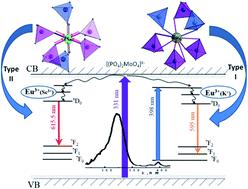Our official English website, www.x-mol.net, welcomes your feedback! (Note: you will need to create a separate account there.)
Structural and optical properties of langbeinite-related red-emitting K2Sc2(MoO4)(PO4)2:Eu phosphors
RSC Advances ( IF 3.9 ) Pub Date : 2020-7-7 , DOI: 10.1039/d0ra04975a Kateryna V Terebilenko 1 , Serhii G Nedilko 1 , Vitalii P Chornii 1, 2 , Vadym M Prokopets 1 , Mykola S Slobodyanik 1 , Volodymyr V Boyko 2
RSC Advances ( IF 3.9 ) Pub Date : 2020-7-7 , DOI: 10.1039/d0ra04975a Kateryna V Terebilenko 1 , Serhii G Nedilko 1 , Vitalii P Chornii 1, 2 , Vadym M Prokopets 1 , Mykola S Slobodyanik 1 , Volodymyr V Boyko 2
Affiliation

|
The concentration series of langbeinite-related solid solutions K2Sc2(MoO4)(PO4)2:xEu (x = 0.1, 0.2, 0.6, 0.8, and 1.0 mol%) has been prepared via a solid state route and the effects of europium content on the phase composition, morphology, crystal structure and luminescence properties have been studied by scanning electron microscopy, X-ray powder diffraction, UV-vis, IR and luminescence spectroscopy. The band gap values have been estimated from UV-vis spectra and are in the range of 3.7–3.8 eV for all concentrations studied. The electronic band structure calculations have shown that Sc d, Mo d and Ophos p states dominate in the band edge region and determine the optical transitions in the K2Sc2(MoO4)(PO4)2 host. The photoluminescence (PL) spectra, intensity and decay time dependences on the Eu3+ concentration revealed complex behavior of europium-containing emitting centers. The PL characteristics indicated the presence of at least two types of luminescence centers. One of them (EuK) is shown to be formed by the Eu3+ ion located within K sites, while the other one is formed by the Eu3+ ions that reside in Sc sites (EuSc). The luminescence color coordinates calculated for K2Sc2(MoO4)(PO4)2:xEu indicated that these ceramics can be potential candidates for UV-based lighting applications as efficient red phosphors.
中文翻译:

与朗贝石相关的红色发射 K2Sc2(MoO4)(PO4)2:Eu 荧光粉的结构和光学性质
通过固态途径制备了浓度系列的镧系元素固溶体 K 2 Sc 2 (MoO 4 )(PO 4 ) 2 : x Eu ( x = 0.1, 0.2, 0.6, 0.8, 和 1.0 mol%)通过扫描电子显微镜、X射线粉末衍射、紫外-可见、红外和发光光谱研究了铕含量对相组成、形貌、晶体结构和发光性质的影响。带隙值是根据紫外可见光谱估计的,所有研究浓度的带隙值都在 3.7-3.8 eV 的范围内。电子能带结构计算表明,Sc d、Mo d 和 O phosp 态在能带边缘区域占主导地位,并决定了 K 2 Sc 2 (MoO 4 )(PO 4 ) 2主体中的光学跃迁。光致发光 (PL) 光谱、强度和衰减时间对 Eu 3+浓度的依赖性揭示了含铕发射中心的复杂行为。PL特性表明存在至少两种类型的发光中心。其中一种(Eu K )显示为由位于K位点内的Eu 3+离子形成,而另一种由位于Sc位点(Eu Sc )中的Eu 3+离子形成。为 K 计算的发光颜色坐标2 Sc 2 (MoO 4 )(PO 4 ) 2 : x Eu 表明这些陶瓷可以作为有效的红色荧光粉用于基于紫外线的照明应用的潜在候选者。
更新日期:2020-07-07
中文翻译:

与朗贝石相关的红色发射 K2Sc2(MoO4)(PO4)2:Eu 荧光粉的结构和光学性质
通过固态途径制备了浓度系列的镧系元素固溶体 K 2 Sc 2 (MoO 4 )(PO 4 ) 2 : x Eu ( x = 0.1, 0.2, 0.6, 0.8, 和 1.0 mol%)通过扫描电子显微镜、X射线粉末衍射、紫外-可见、红外和发光光谱研究了铕含量对相组成、形貌、晶体结构和发光性质的影响。带隙值是根据紫外可见光谱估计的,所有研究浓度的带隙值都在 3.7-3.8 eV 的范围内。电子能带结构计算表明,Sc d、Mo d 和 O phosp 态在能带边缘区域占主导地位,并决定了 K 2 Sc 2 (MoO 4 )(PO 4 ) 2主体中的光学跃迁。光致发光 (PL) 光谱、强度和衰减时间对 Eu 3+浓度的依赖性揭示了含铕发射中心的复杂行为。PL特性表明存在至少两种类型的发光中心。其中一种(Eu K )显示为由位于K位点内的Eu 3+离子形成,而另一种由位于Sc位点(Eu Sc )中的Eu 3+离子形成。为 K 计算的发光颜色坐标2 Sc 2 (MoO 4 )(PO 4 ) 2 : x Eu 表明这些陶瓷可以作为有效的红色荧光粉用于基于紫外线的照明应用的潜在候选者。


























 京公网安备 11010802027423号
京公网安备 11010802027423号